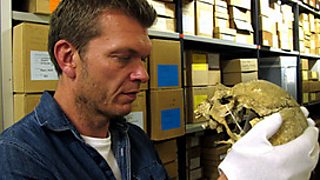"An entire Roman theatre - hidden from the modern world"
Dr Richard Miles follows in the footsteps of the 18th century archaeologists who discovered Herculaneum...
To visit the incredible sites of Pompeii and Herculaneum as a tourist is incredible enough, stepping through wonderfully preserved Roman streets just as they were when Vesuvius erupted in AD79. But to be given the privilege of entering the ancient tunnels of rock created by the first archaeological pioneers to discover Herculaneum is quite another.

Working on this series has provided any number of fantastic opportunities to visit archaeological sites that are well off the beaten track, from the sweltering jungles of southern Mexico to Scandinavian peat bogs, but the underground world beneath Herculaneum topped the lot. The tunnels, hacked by workmen through the hardened pumice, are testimony to the efforts of 18th century archaeology.
The expression 'frozen in time' is an over-used cliché but as my eyes adjusted to this dark world from the bright Mediterranean sun, searing the ground outside, it was an overwhelming thought... not only because I was entering the hidden world of the Romans, but because I was doing so through the eyes of archaeological excavators who had first entered the ground here nearly 300 years ago.
A hard fought privilege
It was spine-tingling. Around every corner there appeared a pile of excavated rubble, a note in the stone scrawled by a workman who regarded the tunnels as "his house", the empty mould of a face in the rock where a valuable statue had been prised away.
This whole place was first discovered in 1709 by a farmer who was digging a well, and was later excavated by the Duke of Elbeuf and then more systematically by a Spanish engineer Rocque Joaquin de Alcubierre.
These early 'excavators' literally burrowed down through the volcanic rock searching for any marble valuables and other artistic treasures that could be brought to the surface and laid claim to. But there was one thing they couldn't remove.
It was the most extraordinary moment of all: an entire Roman theatre. The old tunnels still provide the only access to the ancient theatre, hidden from the modern world.
Due to its fragile state and the dangers posed by dark steep passages, and the water that flows down them, the theatre is closed to the public and my visit was the result of some hard fought negotiating skills from the production team.
Glimpses of a long lost world
Moving through the claustrophobic darkness, the flickering torch light of the guide reveals glimpses of a long lost world - ghostly seating and walls still decorated with coloured plaster and even graffiti scrawled by its clientele nearly 2000 years ago.
The piece de resistance was walking out onto the stage itself. It feels as if the banks of empty benches are merely waiting to once more be filled by a throng of noisy, laughing spectators bringing to an end a two millennia-old silence.
The ghosts of the past then felt very real indeed.
Find out more
Episodes
-
![]()
The quest to prove a biblical truth.
-
![]()
Just where and when did civilisation begin?
-
![]()
Discovering the life of the common man.



